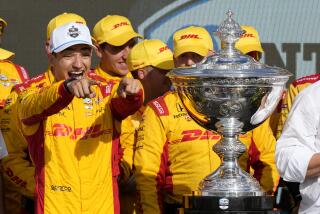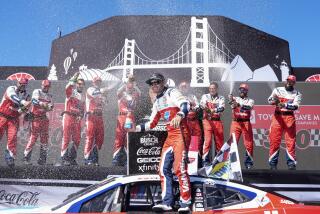SIMONS SAY : Dick Simon Calls Shots for Brayton; His Wife, Dianne Simon, for Luyendyk
- Share via
INDIANAPOLIS — When Dick Simon decided to retire as a race car driver and become a car owner and team manager, he didn’t go half way.
He signed two drivers, Arie Luyendyk and Scott Brayton, to drive a pair of 1989 Lolas, but he complicated his problems by using two engines, a Cosworth V-8 for Luyendyk and a turbocharged stock block Buick for Brayton.
As far as running the team on race day Sunday, however, he’s keeping things in the family.
Simon, 55, a veteran of 17 starts in the Indianapolis 500, will be in Brayton’s pits, and his wife, Dianne, will be making the decisions for Luyendyk.
“She was around helping run the team all the time I was driving, so she knows as much or more than anyone else I could find,” Simon said of the unusual arrangement.
But Simon has always had unusual arrangements.
A former ski jumping and parachute jumping champion, he did not take up racing Indy cars until he was 36, but once in it he set records for perseverance by running 183 races without a victory.
He also was the one who guided Janet Guthrie in her goal to become the first, and still the only, woman to qualify for the Indy 500.
And last year at age 54, he extended his own record as the oldest driver in the 500.
“I thought I’d miss driving, but I haven’t, not a bit,” he said. “I’ve had so much satisfaction in working with Arie and Scotty that I haven’t had time to think about driving myself.”
Both Luyendyk and Brayton came to Simon this season after unhappy experiences with other teams.
“Dick is an exceptional car owner,” Brayton said Thursday after the team put its cars through their final paces during carburetion day. “Having Dick running the team gives Arie and I an added edge because he’s been in the seat himself. When we come in and tell him how the car felt, how it was reacting at different places on the track, he can understand.
“Last year, I would come in and tell my crew chief that something was wrong and either he didn’t believe me, or he had a blank look on his face.”
Simon says that he often knows before his driver gets his helmet off how the car is running.
“I can tell from the look in their eyes. If he’s had a scare, or the car’s not handling right, the fire’s still there when he comes into the pits. If the car’s been handling right, there’s always a smile in their eyes when they come in.”
Both of Simon’s engine programs are factory backed, and factory engineers do all the dyno testing and development, so all Simon’s crew has to do is bolt them in the Lolas.
“It’s really a good deal from our standpoint,” Simon says. “I remember when I used to take my screwdriver or my wrench and make my own changes on the engine. Now it’s all done electronically, by computer, and the engineers take care of it. It’s just another example of how technology is taking over racing and eliminating a lot of the human element.
“But that doesn’t mean we don’t have enough problems. Take this week. We were quite pleased after qualifying to have Scotty (Brayton) in the second row and then we came out Tuesday and found the fuel cell was leaking.
“You don’t just go out and find a fuel cell to fit an Indy car. We had to contact Lola in England and they said they would send one over with the tub from Jim Crawford’s car. But when the tub arrived in Chicago Wednesday night, it didn’t need to clear customs because it had originated in the States but the fuel cell had to go through customs. That meant we had to send a guy up to O’Hare (Airport) just to take care of it.
“By the time the crew got it, it was close to midnight. They worked until about 4 in the morning and then went home for a couple hours sleep and then came back to the track. It’s been that kind of a year for us. We blew a couple of engines, had gear boxes break and had to patch up the car after something broke and Brayton hit the wall.
“But the way the two cars ran today, we’re looking forward to the race.”
In the final workout before Sunday, Luyendyk and Brayton both ran 216 m.p.h. Only four drivers were faster, the fastest being 217.407 by Al Unser.
“I have a great feeling about the race because of the way the car handled on a full load (of methanol fuel),” Luyendyk said. “It also handles real well in traffic and that’s extra important in those first few laps when the turbulence from all the other cars can really throw your car off.”
Brayton knows that all too well.
In last year’s race, Brayton hit the second turn wall on the first lap when traffic was still heavy and when the car spun, it collected Roberto Guerrero’s car, too.
“It was the lowest point in my career,” Brayton said. “The worst thing is that my team never explained what happened. They had some snap-on tabs on the wing that apparently weren’t on tight and after I got through the first turn, the turbulence kicked them off going down the short chute.
“When I tried to turn, it just went, ‘boom,’ into the wall and when it came around I was looking at Guerrero.”
Simon likened it to trying to land an airplane without a tail and rudder.
“You can’t do anything about it when it’s that way,” Simon said.
More to Read
Go beyond the scoreboard
Get the latest on L.A.'s teams in the daily Sports Report newsletter.
You may occasionally receive promotional content from the Los Angeles Times.










